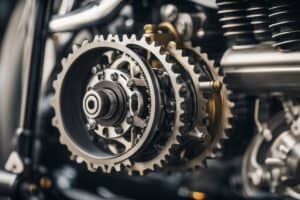Experiencing a rough ride on your beloved motorcycle lately?
It might not just be the road’s fault.
Your engine’s timing chain could be crying out for attention.
Knowing the signs of a faulty timing chain is crucial for any rider.
From unusual noises to performance hiccups, your motorcycle’s engine has ways of signaling help.
Let’s dive into how you can spot these red flags before you’re left stranded on the side of the road.
What is a timing chain?
A timing chain is an integral part of your motorcycle’s engine, silently working away under the casing.
It’s a crucial component, ensuring that the engine’s valves open and close at the precise moments necessary for smooth operation.
Function of a Timing Chain
The timing chain has one primary purpose: to synchronize the rotation of the crankshaft with the camshaft.
This ensures that the engine’s valves operate in harmony with the pistons.
Without this synchronization, the engine would not function properly.
The timing chain:
- Transfers rotational force from the crankshaft to the camshaft
- Keeps the engine’s cycle timed precisely
- Maintains engine efficiency and power
Regular wear and tear can lead to a stretched timing chain, which can disrupt this synchronization and impact your motorcycle’s performance.
Importance of a Timing Chain in a Motorcycle Engine
The timing chain’s role in a motorcycle engine can’t be overstated.
It’s the bridge between various elements that make your ride smooth and powerful.
If the timing chain fails, your motorcycle’s engine could suffer severe damage.
The importance of the timing chain in a motorcycle engine lies in:
- Preventing engine failure: A damaged or broken timing chain can lead to catastrophic engine damage.
- Optimizing performance: A well-maintained timing chain ensures optimal engine performance.
- Fuel efficiency: Proper timing chain operation helps maintain fuel efficiency.
Staying on top of timing chain maintenance is critical for prolonging the lifespan of your motorcycle’s engine and ensuring peak performance during every ride.
Symptoms of timing chain issues in motorcycle engines
1. Engine Misfires
When your motorcycle’s timing chain wears out or stretches, it can lead to an engine misfire.
This problem occurs because the chain can no longer maintain precise control over the timing of the valves, which in turn affects the engine’s combustion process.
You might notice sporadic stuttering or a sudden loss of power during operation, indicating misfires.
It’s vital to address these symptoms promptly to avoid further engine damage.
2. Loud Noise From the Engine
A clear indication of a potential timing chain issue is a loud rattling noise coming from your motorcycle’s engine.
This is often caused by a loose timing chain hitting against the inside of the timing chain cover or other engine components.
As the chain slackens further, this noise may intensify especially during startup or when the engine is idling.
3. Difficulty in Starting the Engine
Another warning sign is when your motorcycle starts to experience difficulty during startup.
If the timing chain has become excessively worn or has even failed, the engine may struggle to turn over or fail to start at all.
If starting your motorcycle becomes more challenging over time, it’s recommended to have the timing chain inspected.
4. Reduced Power and Performance
A malfunctioning timing chain can lead to a noticeable drop in your engine’s performance.
You may find your motorcycle lacking the acceleration it once had, or it might seem to struggle at higher speeds.
Such symptoms suggest that the engine valves and pistons aren’t coordinating effectively, compromising the engine’s ability to deliver full power.
5. Engine Vibrations
Unusual vibrations from within the engine compartment may be a sign of a disturbed timing chain.
These vibrations often result from the engine running out of sync due to a slackened or damaged timing chain.
If you feel increased vibrations coupled with the previously mentioned symptoms, this can be a strong indication that the timing chain needs attention.
Causes of timing chain issues in motorcycle engines
Motorcycle engines rely heavily on the timing chain to maintain precise synchronization between the engine’s camshaft and crankshaft.
When issues arise, understanding the causes is crucial for timely intervention.
1. Wear and Tear
Normal usage over time contributes to wear and tear, an inevitable factor that affects your timing chain.
The constant metal-to-metal contact eventually leads to the stretching of the chain and the degradation of chain links and sprockets.
As the chain stretches, it’s less able to maintain the tight coordination required for the engine valves to open and close at the right times.
- Signs of wear and tear include:
- Visible elongation of the chain
- Shiny or polished spots on links indicating excessive friction
- Broken or damaged chain links
Consider the mileage and age of your motorcycle when assessing if wear and tear is the likely culprit behind timing chain issues.
2. Lack of Lubrication
Proper lubrication is essential for minimizing friction and heat in your motorcycle engine.
When the timing chain lacks lubrication, it can wear out more quickly and increase the risk of engine damage.
- Lack of lubrication can cause:
- Excessive noise from dry chain movement
- Accelerated wear on the chain and associated components
- Increased heat generation leading to potential overheating
Regular oil changes and ensuring the use of quality lubricants will aid in protecting your timing chain from the damaging effects of insufficient lubrication.
3. Incorrect Tensioning
Your timing chain’s tension is crucial for its operation.
Incorrect tensioning—whether too tight or too loose—can have serious consequences.
- A too tight tension can lead to:
- Premature wear on chain and engine bearings
- Unnecessary strain on engine components
- A too loose chain can create:
- Slack that affects engine timing
- Increased potential for the chain to disengage completely
Use the correct tools and manufacturer guidelines to ensure the tension on your timing chain is set accurately.
4. Overheating
Excessive heat within the engine compartment can adversely affect your timing chain.
Overheating can warp engine components and decrease the tensile strength of the timing chain.
- Contributing factors to overheating include:
- Poor cooling system maintenance
- Insufficient coolant levels
- Blocked air flow to the engine
Ensure your motorcycle’s cooling system is functioning properly and check for any signs of obstructions that might hinder airflow or cooling efficiency.
Regular maintenance and inspections can help mitigate the risk of overheating-related timing chain issues.
Diagnosing timing chain issues in motorcycle engines
Visual Inspection
A thorough visual inspection is your first line of defense against timing chain failure.
Start by checking the timing chain cover for any signs of oil leaks or damage.
These could suggest a chain that’s not running smoothly.
Next, if accessible, examine the chain itself.
Look for loose links, visible wear, or corrosion, indications that it’s time for a replacement.
Some motorcycles may require partial disassembly to get a clear view, so consult your service manual for guidance.
Listening for Abnormal Noises
One of the more obvious signs of a timing chain problem is an unusual sound coming from the engine.
When the engine is running, listen carefully for a rattling or clanking noise, particularly at idle or low speeds.
This sound can point to a loose timing chain hitting the inside of the casing.
If you hear anything out of the ordinary, it’s crucial to investigate further, as a timing chain failure could cause severe engine damage.
Checking for Engine Misfires
Engine misfires are telltale signs that your timing chain may be out of sync.
The timing chain is responsible for keeping the engine’s valves opening and closing at the proper times.
When it starts to fail, this synchronization is thrown off.
Unexpected stalling or rough idling could be your clue.
Monitor your engine’s behavior closely for these irregularities, especially if accompanied by the check engine light.
Measuring Engine Performance
Observing changes in the overall engine performance can also hint at timing chain issues.
A drop in horsepower or fuel efficiency could mean the chain’s timing is off, affecting how well the engine operates.
Conduct regular checks using a diagnostic tool to monitor engine performance metrics.
Pay particular attention to changes over time; a gradual decline could point to the need for maintenance or repair.
By being vigilant and conducting regular inspections, you’re more likely to catch timing chain issues before they escalate.
Regular maintenance, as per your motorcycle’s service schedule, cannot be overstressed—it’s the best way to ensure that your engine runs smoothly for miles to come.
Preventing timing chain issues in motorcycle engines
Recognizing the signs of a failing timing chain is crucial to maintaining your motorcycle’s performance and longevity.
By staying alert to the visual cues and listening for unusual noises you can catch issues early.
Don’t overlook the impact of engine misfires or changes in performance—these could be your first hints at underlying timing chain problems.
Remember, regular maintenance isn’t just about prevention; it’s about ensuring your ride remains safe and enjoyable.
Keep up with inspections and address any concerns promptly to keep your motorcycle running smoothly mile after mile.
Frequently Asked Questions
What are the signs of timing chain issues in motorcycle engines?
A timing chain issue can often be identified by a visual inspection for damage or wear, listening for abnormal noises like rattling or clanking, observing engine misfires, and noting changes in engine performance, such as reduced horsepower or fuel efficiency.
How can I diagnose a timing chain problem?
Diagnosing a timing chain problem involves conducting a visual inspection of the chain and its cover, listening for unusual sounds from the engine, checking for engine misfires, and observing any decreases in horsepower or fuel economy.
Can a faulty timing chain affect engine performance?
Yes, a faulty timing chain can significantly affect engine performance.
Symptoms may include a drop in horsepower, decreased fuel efficiency, and engine misfires.
Why is regular maintenance important for timing chain longevity?
Regular maintenance is crucial for timing chain longevity because it allows for early detection and resolution of issues, preventing the problems from escalating and causing more severe engine damage.
As an Amazon Associate we earn from qualifying purchases.










